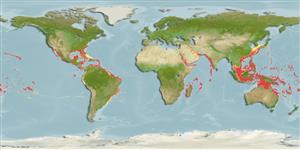Echinoidea |
Camarodonta |
Echinometridae
Environment: milieu / climate zone / пределы глубины / distribution range
экология
; пределы глубины 0 - 139 m (ссылка 81020). Tropical
Indo-Pacific and Western Central Atlantic.
Length at first maturity / Size / Weight / Возраст
половая зрелость: Lm ? range ? - ? cm Max length : 8.0 cm WD самец/пол неопределен; (ссылка 800)
Found subtidally (Ref. 102838). Inhabits hard substrates by boring on rocks in shallow waters (Ref. 800). It is also found on fore-reefs (Ref. 87903). A grazing echinoid, predominantly scraping the substratum of turf algae (Ref. 125618). Feeds on algae (Also Ref. 129602) and small invertebrates. Associated with Athanas indica, which hides between its spines (Ref. 800). Associated with coral communities. Burrowing species (Ref. 129602).
Life cycle and mating behavior
половая зрелость | размножение | нерест | Eggs | Fecundity | Larvae
Members of the class Echinoidea are gonochoric. Fertilization is external. Brooding is common, eggs are held either on the peristome, around the periproct or deep into the concavities on the petaloids. Life cycle: Embryos develop into planktotrophic larvae (echinoplateus) and live for several months before they sink to the bottom using their tube feet to adhere on the ground where they metamorphose into young urchins.
Основная ссылка
ссылки | координатор | соавторы
Schoppe, S. 2000 A guide to common shallow water sea stars, brittle stars, sea urchins, sea cucumbers and feather stars (echinoderms) of the Philippines. Times Media Private Limited, Singapore. 144 p. (ссылка 800)
Статус Красного Списка МСОП
(ссылка 130435: Version 2025-1)
Статус СИТЕС (ссылка 108899)
Not Evaluated
CMS (ссылка 116361)
Not Evaluated
Угроза для людей
Использование человеком
| FishSource |
инструменты
дополнительная информация
Population dynamicsростMax. ages / sizesLength-weight rel.Length-length rel.Размерный составMass conversionчисленность Life cycleразмножениеполовая зрелостьFecundityнерестEggsРазвитие икрыLarvae Human RelatedStamps, coins, misc.
ресурсы в Интернет
Estimates based on models
Preferred temperature
(Ref.
115969): 23.3 - 28.8, mean 27.1 (based on 1386 cells).
устойчивость к внешним воздействиям
высокий, минимальное время удвоения популяции до 15 месяцев (K=0.4).
Fishing Vulnerability
Low to moderate vulnerability (29 of 100).
Категория цены
Unknown.
